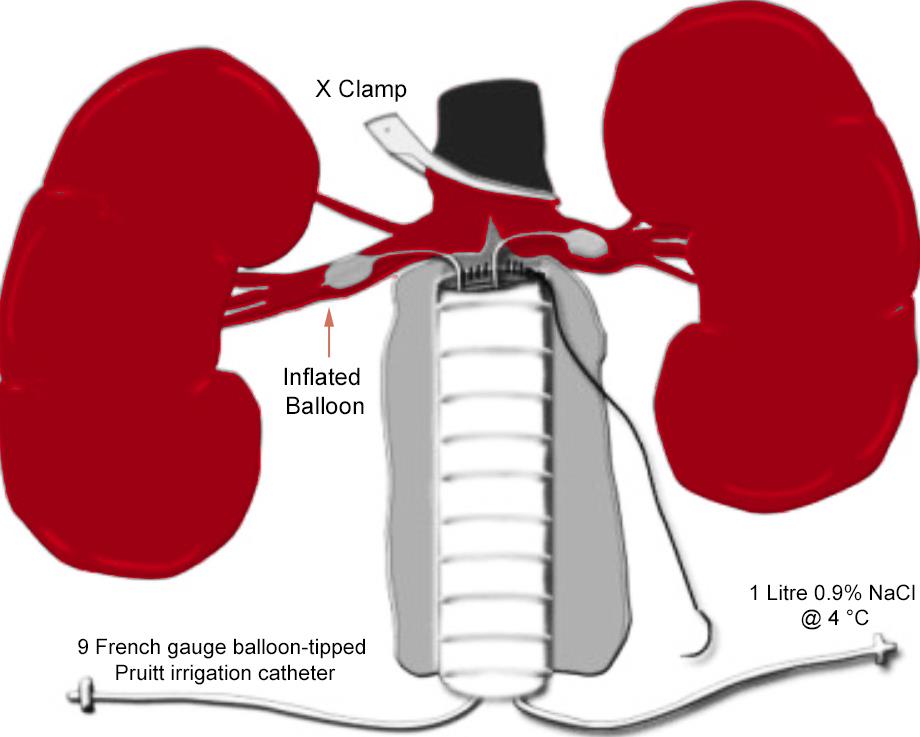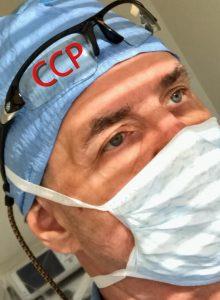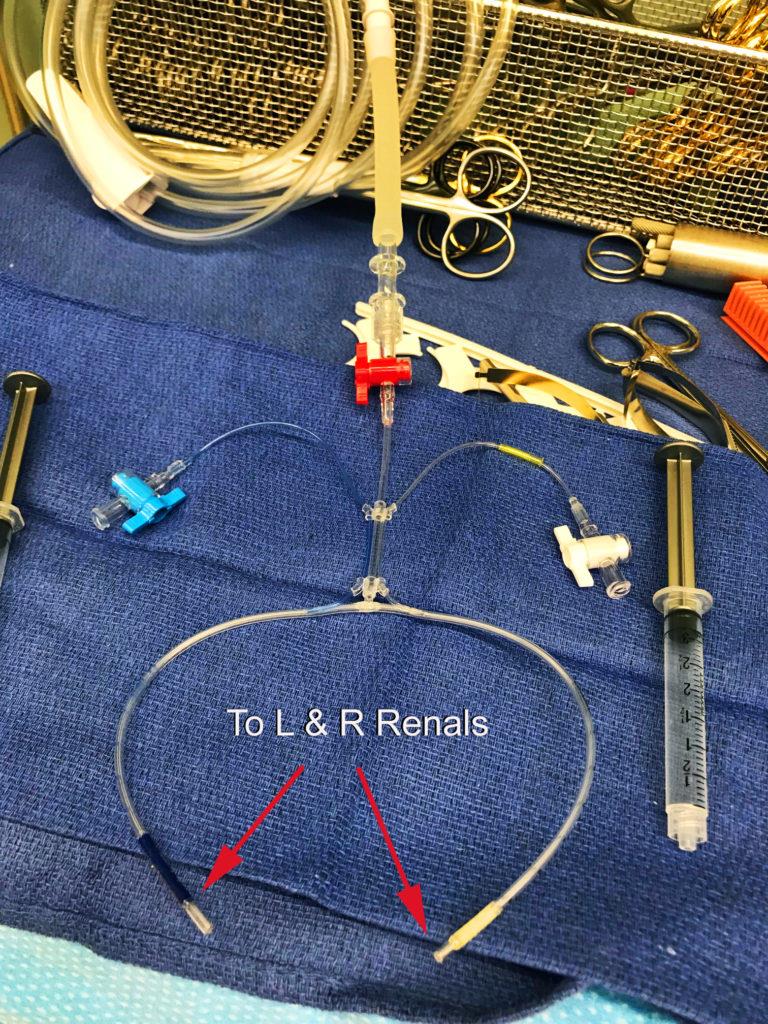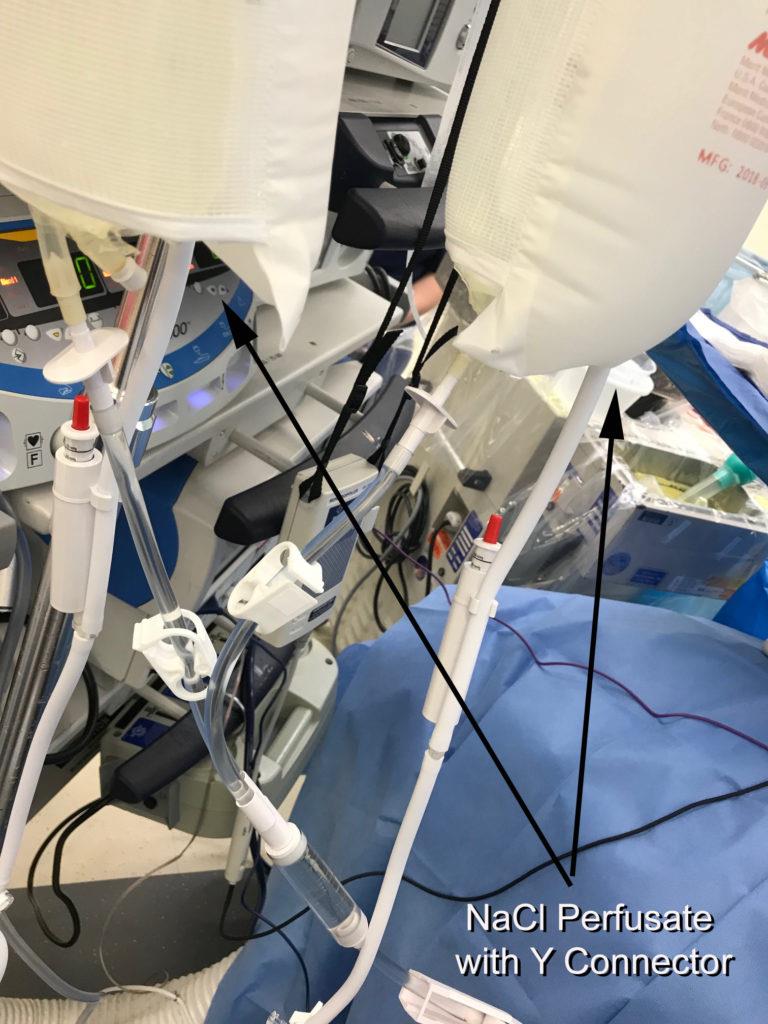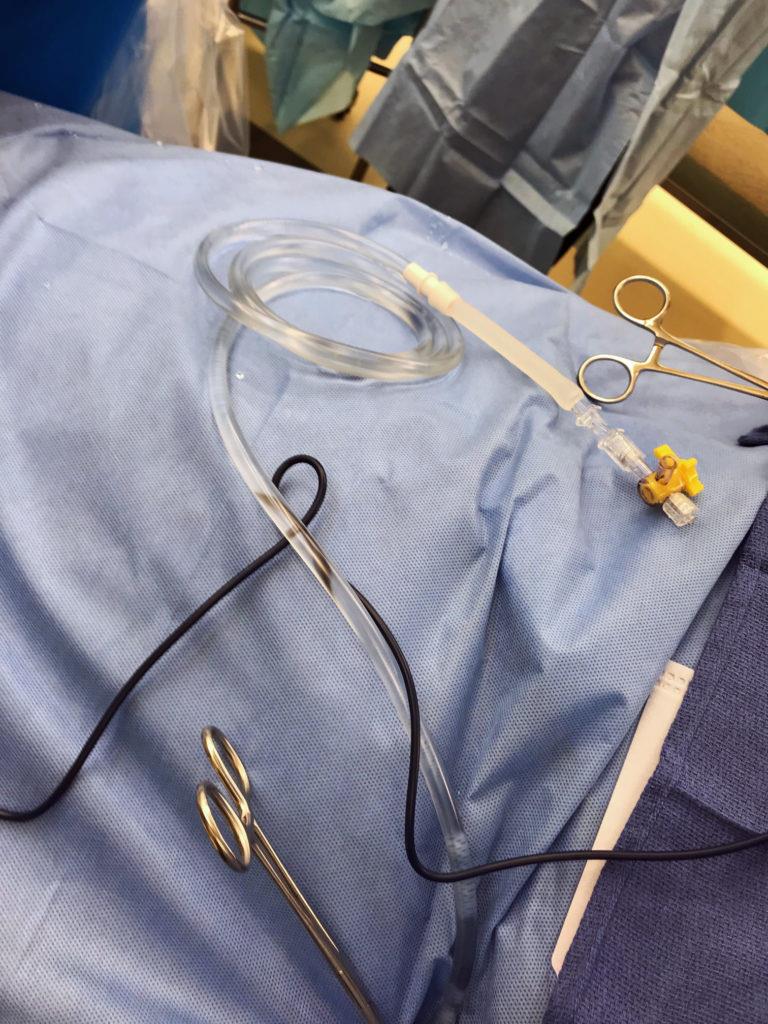Continuous Crystalloid Renal Perfusion During Open AAA Repair?

Editor’s Note:
During a pretty hectic day in the OR, we had an add on case that initially seemed fairly routine- a request for autotransfusion for an upcoming open AAA repair. The case was scheduled for another day, and I just happened to run into the surgeon in the Drs lounge- and he asked for crystalloid renal perfusion during this case. That was a first for me- but it piqued my interest so I suggested employing a Low Tech approach used back in the day for delivering cardioplegia to the heart with the X-Clamp on- from the head of the bed via pressurised (pressure bag) cold crystalloid cardioplegia directly to the aortic root. In this case obviously, the perfusate would be delivered to the renal artery directly with a balloon tipped catheter once the aorta was open.
I asked my colleague Dennis B- (a perfusionist for whom I have great respect for)– for his perspective and opinion. He suggested using the Quest MPS delivery system that we currently use at this institution to deploy cardioplegia during CPB cases- using it as a stand-alone delivery system and dialing it in to use 100% crystalloid. I considered it- and ultimately went with a Low Tech option for the primary reason that I didn’t want to leave one of my HLMs “naked” sans cardioplegia delivery system- in case an emergency popped up.
My questions to the readership are the following:
- Are you currently and routinely providing renal protection for open AAA’s?
- What technique did you use?
- Share and describe the technique?
UpDate:
Here is what we came up with for our delivery system. The night before 6 (1000 ml NaCl IV Solution Bags) were refrigerated prior to the next morning’s case.
This article provided courtesy of SCIENCE DIRECT (Click image above to view source article)
Objectives
Surgical treatment of JAAs (juxtarenal aortic aneurysms) requires suprarenal aortic cross-clamping, causing temporary renal artery occlusion. We implemented a standardized protocol of hypothermic renal perfusion for all elective JAA operations.
Design
Materials and Methods
Between January 2000 and January 2006, a total of 258 elective abdominal aortic aneurysm repairs (AAA) were performed, of which 23 consecutive patients underwent elective JAA repair with aortic clamping just above the renal arteries. The latter all received routine continuous renal hypothermic perfusion during the entire period of renal ischemia, and were included in the present study. Excluded from this study were type IV thoracoabdominal aneurysms and ruptured aneurysms.
The mean age of the 5 women and 18 men was 70 ± 11 years. Eight patients (35%) presented with back pain or abdominal pain, fifteen patients (65%) were asymptomatic (Table 1). The mean diameter of the aneurysms was 6.7 ± 1.3 cm. One woman had a symptomatic AAA of 4.5 cm diameter. A smoking history was common (74%). Fifty-seven percent of the patients had undergone prior abdominal surgery and two of them had undergone previous aortic grafting. Preoperative workup included cardiac assessment, abdominal ultrasound and angiography or CT scanning to determine the size and extent of the aneurysm. Two patients had multiple renal arteries.
Table 1. Characteristics of 23 patients who underwent elective surgery for juxtarenal abdominal aortic aneurysm during a six years period in our hospital
| n∗ | % | |
|---|---|---|
| Gender | ||
| Male/Female | 18/5 | 78/22 |
| Age | ||
| Mean | 70 | |
| Range | 39–83 | |
| Associated disease | ||
| Chronic Obstructive Pulmonary Disease | 4 | 17 |
| Coronary heart disease | 5 | 22 |
| Hypertension | 13 | 57 |
| Diabetes Mellitus | 1 | 4 |
| Hypercholesterolaemia | 10 | 43 |
| Smoking | 17 | 74 |
| Previous surgery | ||
| Abdominal surgery | 13 | 57 |
| Aortic stentgrafting | 2 | 9 |
| Preoperative serum creatinine level (mg/dL)∗ | ||
| <1.25 | 11 | 48 |
| 1.25–1.80 | 8 | 35 |
| >1.80 | 4 | 17 |
- ∗n = number of patients; mg = milligram; dL = deciliter.
Mean preoperative serum creatinine was 1.66 ± 1.00 mg/dL (147 μmol/L). Preoperative serum creatinine ≥ 1.25 mg/dL (111 μmol/L) was defined as preoperative impaired renal function. Twelve patients (52%) had preoperative renal insufficiency (Table 1). In four of the latter the preoperative serum creatinine level was >1.8 mg/dL (159 μmol/L), while in two of them it was >3.0 mg/dL (265 μmol/L), of which one required chronic hemodialysispreoperatively. In four patients one of the kidneys was found to be atrophic (two of them had preoperative creatinine ≥ 1.25 mg/dL, but < 1.80 mg/dL).
Surgical technique
This diagram (taken from another article) demonstrates the surgical approach to the renals
All patients received Sufentanil and Bupivacaïne epidurally, general anaesthesia with Isofluran (0.9%) and a standard transperitoneal approach to the aorta. Before placing the aortic cross-clamp 5000 units of heparin were administered intravenously. The upper aortic clamp was placed proximal to both renal arteries (n = 16) or proximal to only the left (n = 3) or right renal artery (n = 2). Perfusion of the kidneys with cold NaCl solution was then started and continued for the duration of the renal ischemia (see below). After completion of the proximal anastomosis, the suprarenal aortic clamp was replaced on the aortic graft in order to restore blood flow to the kidneys. Renal blood flow was examined intraoperatively using Doppler in order to confirm restoration of renal blood flow. Twelve patients received an aortic tube graft and eleven a bifurcated aortoiliac graft. Reimplantation of the renal arteries was performed in four patients. In one patient an endarterectomy of the renal artery was performed.
Cold perfusion of the kidneys was applied in all patients during the whole period of renal ischemia. One litre of 0.9% NaCl solution with an initial temperature of 4 °C was placed one meter above each kidney. A 9 French gauge balloon-tipped Pruitt irrigation catheters (LeMaitre Vascular Inc, Burlington USA) were inserted in the orifice of the renal arteries from within the opened aneurysm (see Fig. 1). First, a 300 mL bolus of this solution was quickly infused to instantly induce renal hypothermia. Then renal perfusion was continued at a rate of approximately 20 mL/minute. Measurement of the temperature of this solution at the point of entrance into a kidney revealed a rise from 4 °C in the beginning to 16 °C at the end of the perfusion. The catheters in the renal arteries were removed after completion of the proximal aortic anastomosis.

Fig. 1. Insertion of the 9 F Balloon-tipped Pruitt irrigation catheters (LeMaitre Vascular Inc, Burlington USA) from the opened juxtarenal aneurysm in the renal orifices to provide renal hypothermia with cold NaCl-solution during aortic graft placement.
Results
None of the patients suffered from postoperative acute renal failure and mortality within 30 days was zero. The duration of renal ischemia ranged from 25 to 60 minutes, with a mean of 37.2 ± 11.7 minutes. In 4 patients renal ischemic time exceeded 50 minutes (Fig. 2). Mean total operation time was 215.2 ± 56.7 minutes, with a mean total aortic clamping time of 58.4 ± 24.4 minutes. Patients were divided in three groups based on their preoperative serum creatinine level. Group one had normal preoperative renal function (<1.25 mg/dL), group 2 had preoperative impaired renal function (1.25–1.80 mg/dL) and group 3 had preoperative renal insufficiency (>1.80 mg/dL). None of the patients in the three groups showed a rise in serum creatinine exceeding 0.50 mg/dL (44 μmol/L) above the admission level, defined as transient azotemia.10, 11 Only one patient experienced a rise of serum creatinine >25%. Five patients did not show any rise in serum creatinine level (Fig. 2; note that the two patients with the highest preoperative levels (solid ellipsoids) had no deterioration of renal function). Renal artery reimplantation (n = 4, ischemia time: 30–45 min) had no clear influence on rise in serum creatinine level (mean 0.21 ± 0.19 mg/dL).

Fig. 2. Renal ischemia time (x-axis) versus highest rise in serum creatinine level (y-axis). Three groups were made based on the preoperative serum creatinine level: cirkels = <1.25 mg/dL (n = 11); squares = 1.25–1.80 mg/dL (n = 8) and ellipsoids = >1.8 mg/dL (n = 4), with the two solid ellipsoids >3.0 mg/dL.
Postoperative rise in serum creatinine level was not related to renal ischemia time (Spearman rank correlation = 0.24, p = 0.27; Fig. 2), total aortic clamping time, presentation with symptomatic AAA, tube or aortoiliac grafts, clamping above two or one renal artery, one or two functioning kidneys, surgery with or without renal implantation or preoperative renal function (Table 2). The peak in serum creatinine level occurred on average at postoperative day 3 ± 0.8. In most of the patients (56%) the postoperative serum creatinine level had returned to baseline the day after its peak. In all three groups the serum creatinine levels on discharge from the hospital were equal to or somewhat lower than preoperatively (Fig. 3). The mean hospital stay was 12 ± 5 days. Patient records at 6 months showed no renal complications.
Table 2. Renal ischemia time and the highest rise of serum creatinine in the three groups based on the preoperative serum creatinine level
| Preoperative serum creatinine level (mg/dL)∗ | ||||
|---|---|---|---|---|
| <1.25 | 1.25–1.80 | >1.80 | P value | |
| (n = 11)∗ | (n = 8) | (n = 4) | ||
| Mean renal ischemic time (minutes) | 40.0 ± 13.5 | 30.0 ± 11.3 | 35.0 ± 6.3 | p = 0.50 |
| Mean rise in serum creatinine (mg/dL) | 0.14 ± 0.14 | 0.15 ± 0.15 | 0.16 ± 0.15 | p = 0.94 |
- ∗mg = milligram; dL = deciliter; n = number of patients.

Fig. 3. Serum creatinine levels preoperatively (grey), at their peak postoperatively (black) and at the last day in hospital (white). Three groups were made based on the preoperative creatinine level: <1.25 mg/dL (n = 11), 1.25–1.80 mg/dL (n = 8) and >1.8 mg/dL (n = 4). Presented are the medians.
The occurrence of larger renal atheroembolism was unlikely based on total restoration of renal blood flow as assessed intraoperatively by ultrasound Doppler. Non-renal postoperative complications were observed in 7 patients (26%), including respiratory failure (n = 3), cardiac failure (n = 1) and haemorrhage (n = 3). During relaparotomy blood from the splenic hilus, a duodenal ulcer, and diffuse retroperitoneal haemorrhage were found. Average blood loss was 2237 ± 1608 mL. A temporary drop of body core temperature of mean 0.5 ± 0.3 °C during cooling of the kidneys was observed.
Discussion
The present single-center study suggests that continuous hypothermic perfusion of the kidneys after an initial cold bolus may reduce deterioration of renal function after ischemiaand reperfusion during elective repair of juxtarenal aortic aneurysms. This also holds for patients with increased preoperative levels of serum creatinine and/or duration of renal ischemia between 50–60 minutes. However, a limitation of this study is the absence of a comparative group due to an ethical constraint in our hospital, which prescribed routine renal cooling for all elective JAA repairs.
Rates of mortality and renal morbidity are the main issues concerning the safety and feasibility of juxtarenal and suprarenal aortic aneurysm surgery.12 Transient azotemia is reported in 14–50% of the patients, while a new onset of dialysis was seen in 0–13%.2, 3, 4, 5, 6, 7, 8, 9, 10, 11, 12, 13, 14, 15, 16, 17, 18, 19, 20, 21, 22, 23 In our study none of the patients died within 30 days, no dialysis was required postoperatively, and the highest rise in serum creatinine level did not exceed the critical value of 0.50 mg/dL. Acute renal insufficiency post AAA repair is associated with a mortality of 25% to 50%.24 Postoperative renal insufficiency is usually secondary to acute tubular necrosis, while atheroemboli due to the suprarenal aortic clamping may be another cause.14
Several studies have shown that the risk for postoperative renal failure after suprarenal aortic cross clamping for elective AAA repair is low in case of renal ischemia times below 20 minutes, but that it increases 10 times if the clamping time lasts more than 50 minutes. However, the critical renal ischemic time remains controversial.3, 6, 11 Longer ischemia times, even up to 100 minutes, do occur and aren’t always predictable.6, 9 In our series, the renal ischemia time exceeded 50 minutes in four patients. None of these patients showed a significant rise in serum creatinine postoperatively or developed transient renal failure or dialysis in the postoperative course. However, this should still be interpreted with care given the lack of a control group in this study.
One of the major determinants of postoperative renal failure is preoperative renal insufficiency. In our series, preoperative renal insufficiency was present in twelve patients (52%). Also in these patients we observed no significant rise in serum creatinine level postoperatively, which seems to corroborate the efficacy of our cooling strategy to prevent the occurrence of renal dysfunction postoperatively.
Peroperative measures to preserve renal function are still a matter of debate during juxtarenal aortic aneurysm repair. Critics of preservation techniques state that renal perfusion does not protect against renal ischemic damage and that total ischemia times are elongated by these extra proceedings, thereby increasing the risk of harming postoperative renal function.25 The continuous cooled perfusion technique as described in this article is swift and doesn’t interfere with the juxtarenal aortic anastomosis. Another criticism is that dissection of the renal arteries could occur during insertion of the balloon-tipped Pruitt irrigation catheters. However, in all of our patients, restoration of renal artery blood flow was confirmed with intraoperative Doppler examination. Although in our series the use of renal hypothermiaresulted in a drop of body core temperature of 0.5 ± 0.3 °C, this was not associated with complications and seemed to be well tolerated, as has also been reported.26
Experimental studies have demonstrated that renal hypothermia preserves renal function by reducing its oxygen consumption. Renal oxygen consumption is reduced to 40% when the renal parenchyma is cooled to 30 °C, to 15% at 20 °C, and to less than 5% at 10 °C.27, 28, 29, 30, 31 More recent studies have, on the other hand, concentrated on additives to the perfusion solution of the kidney or agents (e.g. PGE, L-arginine) to protect the kidney from ischemia/reperfusion injury, rather than on cooling.32, 33, 34, 35 Also in kidney transplantation surgery additives are being examined to improve cold preservation of the kidney.36, 37 In humans, organ perfusion for preservation is more often used and studied during thoracoabdominal aortic aneurysm repair (ThAAA).38, 39, 40, 41, 42, 43 Köksoy et al.have indicated that selective cold crystalloid perfusion offers superior renal protection when compared with normothermic blood during extensive ThAAA repair.44 PGE1 addition to the perfusion fluid during ThAAA surgery was of no advantage over 4 °C Ringer’s lactate plus 1000 IU of heparin/l alone.45
At present endovascular treatment for aortic aneurysms is becoming more and more widespread and versatile.46 However, the neck of a juxtarenal aneurysm is often too short for stable stent-graft implantation. Fenestrations in the stent-graft permit implantation at a more favorable level by providing a means for flow to the renal arteries, although suprarenal fixation could have effect on the renal function.47 Several studies have examined postoperative renal function after endovascular aneurysm repair.48 Alsac et al. have found a decline in renal function over time after endovascular aortic repair. This is probably due to multiple factors and not the suprarenal fixation.49 In most cases, juxta and suprarenal aneurysms still require open surgery, while future endovascular branch graft repairs ultimately will require comparison with open repair.
In conclusion, a standardized strategy to routinely apply renal hypothermia during the ischemic period of elective JAA surgery may protect renal function, even in patients with preoperative renal failure.
References
- 1
-
S.M. Taylor, J.L. Mills, R.M. FujitaniThe juxtarenal abdominal aortic aneurysm. A more common problem than previously realized?Arch Surg, 129 (1994), pp. 734-737
- 2
-
W.L. Breckwoldt, W.C. Mackey, M. Belkin, T.F. O’Donnell Jr.The effect of suprarenal cross-clamping on abdominal aortic aneurysm repairArch Surg, 127 (1992), pp. 520-524
- 3
-
F.A. Kudo, T. Nishibe, K. Miyazaki, T. Murashita, K. Yasuda, M. Ando, et al.Postoperative renal function after elective abdominal aortic aneurysm repair requiring suprarenal aortic cross-clampingSurg Today, 34 (2004), pp. 1010-1013
- 4
-
T.P. Sarac, D.G. Clair, N.R. Hertzer, R.K. Greenberg, L.P. Krajewski, P.J. O’Hara, et al.Contemporary results of juxtarenal aneurysm repairJ Vasc Surg, 36 (2002), pp. 1104-1111
- 5
-
T. Sasaki, S. Ohsawa, M. Ogawa, M. Mukaida, T. Nakajima, K. Komoda, et al.Postoperative renal function after an abdominal aortic aneurysm repair requiring a suprarenal aortic cross-clampSurg Today, 30 (2000), pp. 33-36
- 6
-
E. Wahlberg, P.J. Dimuzio, R.J. StoneyAortic clamping during elective operations for infrarenal disease: the influence of clamping time on renal functionJ Vasc Surg, 36 (2002), pp. 13-18
- 7
-
B.T. Allen, C.B. Anderson, B.G. Rubin, M.W. Flye, D.S. Baumann, G.A. SicardPreservation of renal function in juxtarenal and suprarenal abdominal aortic aneurysm repairJ Vasc Surg, 17 (1993), pp. 948-958
- 8
-
S. Ockert, H. Schumacher, D. Bockler, K. Malcherek, J. Hansmann, J. AllenbergComparative early and midterm results of open juxtarenal and infrarenal aneurysm repairLangenbecks Arch Surg, 392 (2007), pp. 725-730
- 9
-
A.D. Shepard, D.F. Tollefson, D.J. Reddy, J.R. Evans, J.P. Elliott Jr., R.F. Smith, et al.Left flank retroperitoneal exposure: a technical aid to complex aortic reconstructionJ Vasc Surg, 14 (1991), pp. 283-291
- 10
-
C.A. West, A.A. Noel, T.C. Bower, K.J. Cherry Jr., P. Gloviczki, T.M. Sullivan, et al.Factors affecting outcomes of open surgical repair of pararenal aortic aneurysms: a 10-year experienceJ Vasc Surg, 43 (2006), pp. 921-927
- 11
-
S.M. Giulini, S. Bonardelli, N. Portolani, M. Giovanetti, G. Galvani, R. Maffeis, et al.Suprarenal aortic cross-clamping in elective abdominal aortic aneurysm surgeryEur J Vasc Endovasc Surg, 20 (2000), pp. 286-289
- 12
-
G. Faggioli, A. Stella, A. Freyrie, M. Gargiulo, S. Tarantini, M. Rodio, et al.Early and long-term results in the surgical treatment of juxtarenal and pararenal aortic aneurysmsEur J Vasc Endovasc Surg, 15 (1998), pp. 205-211
- 13
-
J.M. Jean-Claude, L.M. Reilly, R.J. Stoney, L.M. MessinaPararenal aortic aneurysms: the future of open aortic aneurysm repairJ Vasc Surg, 29 (1999), pp. 902-912
- 14
-
R.M. Green, J.J. Ricotta, K. Ouriel, J.A. DeWeeseResults of supraceliac aortic clamping in the difficult elective resection of infrarenal abdominal aortic aneurysmJ Vasc Surg, 9 (1989), pp. 124-134
- 15
-
C.K. Shortell, M. Johansson, R.M. Green, K.A. IlligOptimal operative strategies in repair of juxtarenal abdominal aortic aneurysmsAnn Vasc Surg, 17 (2003), pp. 60-65
- 16
-
E.S. Crawford, W.C. Beckett, M.S. GreerJuxtarenal infrarenal abdominal aortic aneurysm. Special diagnostic and therapeutic considerationsAnn Surg, 203 (1986), pp. 661-670
- 17
-
P.G. Qvarfordt, R.J. Stoney, L.M. Reilly, C.G. Skioldebrand, J. Goldstone, W.K. EhrenfeldManagement of pararenal aneurysms of the abdominal aortaJ Vasc Surg, 3 (1986), pp. 84-93
- 18
-
R.J. Stoney, C.G. Skioldebrand, P.G. Qvarfordt, L.M. Reilly, W.K. EhrenfeldJuxtarenal aortic atherosclerosis. Surgical experience and functional resultAnn Surg, 200 (1984), pp. 345-354
- 19
-
R. Ayari, N. Paraskevas, E. Rosset, B. Ede, A. BranchereauJuxtarenal aneurysm. Comparative study with infrarenal abdominal aortic aneurysm and proposition of a new classificationEur J Vasc Endovasc Surg, 22 (2001), pp. 169-174
- 20
-
R. Chiesa, E.M. Marone, C. Brioschi, S. Frigerio, Y. Tshomba, G. MelissanoOpen repair of pararenal aortic aneurysms: operative management, early results, and risk factor analysisAnn Vasc Surg, 20 (2006), pp. 739-746
- 21
-
T.A. Chuter, J.C. Parodi, M. Lawrence-BrownManagement of abdominal aortic aneurysm: a decade of progressJ Endovasc Ther, 11 (2004 Dec), pp. 82-95
- 22
-
G.E. Poulias, N. Doundoulakis, B. Skoutas, E. Prombonas, H. Haddad, K. Papaioannou, et al.Juxtarenal abdominal aneurysmectomyJ Cardiovasc Surg (Torino), 33 (1992), pp. 324-330
- 23
-
J.R. Schneider, R.J. Gottner, J.F. GolanSupraceliac versus infrarenal aortic cross-clamp for repair of non-ruptured infrarenal and juxtarenal abdominal aortic aneurysmCardiovasc Surg, 5 (1997), pp. 279-285
- 24
-
V.S. Kashyap, R.P. Cambria, J.K. Davison, G.J. L’ItalienRenal failure after thoracoabdominal aortic surgeryJ Vasc Surg, 26 (1997), pp. 949-955
- 25
-
T.J. Nypaver, A.D. Shepard, D.J. Reddy, J.P. Elliott Jr., R.F. Smith, C.B. ErnstRepair of pararenal abdominal aortic aneurysms. An analysis of operative managementArch Surg, 128 (1993), pp. 803-811
- 26
-
R.A. Zager, R. AltschuldBody temperature: an important determinant of severity of ischemic renal injuryAm J Physiol, 251 (1986), pp. F87-F93
- 27
-
M.N. LevyOxygen consumption and blood flow in the hypothermic, perfused kidneyAm J Physiol, 197 (1959), pp. 1111-1114
- 28
-
R.A. Zager, D.J. Gmur, C.R. Bredl, M.J. EngDegree and time sequence of hypothermic protection against experimental ischemic acute renal failureCirc Res, 65 (1989), pp. 1263-1269
- 29
-
O. Dottori, S. Ekestrom, L.O. HanssonLocal cooling of the kidney using perfusion technique. Animal experimental studies with special regard to the type of perfusion fluid and the perfusion pressureActa Chir Scand, 124 (1962), pp. 80-86
- 30
-
R.B. HarveyEffects of temperature on function of isolated dog kidneyAm J Physiol, 197 (1959), pp. 181-186
- 31
-
G. Semb, J. Krog, K. JohansenRenal metabolism and blood flow during local hypothermia, studied by means of renal perfusion in situActa Chir Scand Suppl, 253 (1960), pp. 196-202
- 32
-
N. Ahmad, J.R. Pratt, D.J. Potts, J.P. LodgeComparative efficacy of renal preservation solutions to limit functional impairment after warm ischemic injuryKidney Int, 69 (2006), pp. 884-893
- 33
-
I.M. Mahmoud, Ael.-A. Hussein, M.E. Sarhan, A.A. Awad, I. El DesokyRole of combined L-arginine and prostaglandin E1 in renal ischemia-reperfusion injuryNephron Physiol, 105 (2007), pp. 57-65
- 34
-
S.R. Inman, N.A. Davis, M.E. Mazzone, K.M. Olson, V.A. Lukaszek, K.N. YoderSimvastatin and L-arginine preserve renal function after ischemia/reperfusion injuryAm J Med Sci, 329 (2005), pp. 13-17
- 35
-
S.I. Myers, L. Wang, F. Liu, L.L. BartulaSuprarenal aortic clamping and reperfusion decreases medullary and cortical blood flow by decreased endogenous renal nitric oxide and PGE2 synthesisJ Vasc Surg, 42 (2005), pp. 524-531
- 36
-
T. Ahlenstiel, G. Burkhardt, H. Köhler, M.K. KuhlmannImproved cold preservation of kidney tubular cells by means of adding bioflavonoids to organ preservation solutionsTransplantation, 81 (2006), pp. 231-239
- 37
-
A. Sandouka, B.J. Fuller, B.E. Mann, C.J. Green, R. Foresti, R. MotterliniTreatment with CO-RMs during cold storage improves renal function at reperfusionKidney Int, 69 (2006), pp. 239-247
- 38
-
M.J. Jacobs, R.G. van Eps, D.S. de Jong, G.W. Schurink, B. MochtarPrevention of renal failure in patients undergoing thoracoabdominal aortic aneurysm repairJ Vasc Surg, 40 (2004), pp. 1067-1073
- 39
-
M.J. Jacobs, L. Eijsman, S.A. Meylaerts, R. Balm, D.A. Legemate, P. de Haan, et al.Reduced renal failure following thoracoabdominal aortic aneurysm repair by selective perfusionEur J Cardiothorac Surg, 14 (1998), pp. 201-205
- 40
-
M.J. Jacobs, B.A. de Mol, D.A. Legemate, D.J. Veldman, P. de Haan, C.J. KalkmanRetrograde aortic and selective organ perfusion during thoracoabdominal aortic aneurysm repairEur J Vasc Endovasc Surg, 14 (1997), pp. 360-366
- 41
-
H.T. Hassoun, C.C. Miller 3rd, T.T. Huynh, A.L. Estrera, J.J. Smith, H.J. SafiCold visceral perfusion improves early survival in patients with acute renal failure after thoracoabdominal aortic aneurysm repairJ Vasc Surg, 39 (2004), pp. 506-512
- 42
-
C. Yamashita, M. Okada, K. Ataka, M. Yoshida, H. Nohara, T. Azami, et al.Surgical results for thoraco-abdominal aneurysm by modified DeBakey method using centrifugal biopump and renal cryopreservationCardiovasc Surg, 39 (1998), pp. 399-404
- 43
-
Y. Kuniyoshi, K. Koja, K. Miyagi, T. Uezu, S. Yamashiro, K. Arakaki, et al.Selective visceral perfusion during thoracoabdominal aortic aneurysm repairAnn Thorac Cardiovasc Surg, 10 (2004), pp. 367-372
- 44
-
C. Köksoy, S.A. LeMaire, P.E. Curling, S.A. Raskin, Z.C. Schmittling, L.D. Conklin, et al.Renal perfusion during thoracoabdominal aortic operations: cold crystalloid is superior to normothermic bloodAnn Thorac Surg, 73 (2002), pp. 730-738
- 45
-
L. Reiher, H. Vosberg, W. SandmannKidney protection in preventing post-ischaemic renal failure during thoracoabdominal aortic aneurysm repair: does prostaglandin E1 together with cooling provide more protection than cooling alone?Vasa, 30 (2001), pp. 21-23
- 46
-
R. Moore, C.A. Hinojosa, S. O’Neill, T.M. Mastracci, C.S. CinaFenestrated Endovascular grafts for juxtarenal aortic aneurysms: a step by step technical approachCatheter Cardiovasc Interv, 69 (2007), pp. 554-571
- 47
-
T.A. ChuterFenestrated and branched stent-grafts for thoracoabdominal, pararenal and juxtarenal aortic aneurysm repairSemin Vasc Surg, 20 (2007), pp. 90-96
- 48
-
M.E. O’Donnell, Z. Sun, R.J. Winder, P.K. Ellis, L.L. Lau, P.H. BlairSuprarenal fixation of endovascular aortic stent grafts: assessment of medium-term to long-term renal function by analysis of juxtarenal stent morphologyJ Vasc Surg, 45 (2007), pp. 694-700
- 49
-
J.M. Alsac, C.K. Zarins, M.A. Heikkinen, J. Karwowski, F.R. Arko, P. Desgranges, et al.The impact of aortic endografts on renal functionJ Vasc Surg, 41 (2005), pp. 926-930
